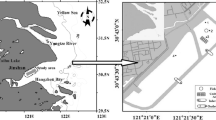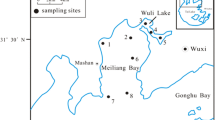Abstract
The distribution of phytoplankton and its correlation with environmental factors were studied monthly during August 2012 to July 2013 in the Yantian Bay. A total of 147 taxa of phytoplankton were identified, and the average abundance was in the range of 0.57×104 to 7.73×104 cell/L. A total of 19 species dominated the phytoplankton assemblages, and several species that are widely reported to be responsible for microalgae blooms were the absolutely dominant species, such as Skeletonema costatum, Navicula sp., Thalassionema nitzschioides, Pleurosigma sp., and Licmophora abbreviata. The monthly variabilities in phytoplankton abundance could be explained by water temperature, dissolved oxygen, salinity, dissolved inorganic nitrogen (DIN), and suspended solids. The results of a redundancy analysis showed that pH and nutrients, including DIN and silicate (SiO4), were the most important environmental factors controlling phytoplankton assemblages in specific months. It was found that nutrients and pH levels that were mainly influenced by mariculture played a vital role in influencing the variation of phytoplankton assemblages in the Yantian Bay. Thus, a reduction of mariculture activities would be an effective way to control microalgae blooms in an enclosed and intensively eutrophic bay.
Similar content being viewed by others
References
Byun D S, Wang Xiaohua, Zavatarelli M, et al. 2007. Effects of resuspended sediments and vertical mixing on phytoplankton spring bloom dynamics in a tidal estuarine embayment. J Mar Syst, 67(1–2): 102–118
Chen C L, Qiu Guohao. 2014. The long and bumpy journey: Taiwan’s aquaculture development and management. Mar Policy, 48: 152–161
da Silva C A, Train S, Rodrigues L C. 2005. Phytoplankton assemblages in a Brazilian subtropical cascading reservoir system. Hydrobiologia, 537(1–3): 99–109
de Jonge V N, Elliott M, Orive E. 2002. Causes, historical development, effects and future challenges of a common environmental problem: eutrophication. Hydrobiologia, 475(1): 1–19
Du Guoying, Chung I K, Xu Henglong. 2016. Insights into community–based bioassessment of environmental quality status using microphytobenthos in estuarine intertidal ecosystems. Acta Oceanol Sin, 35(6): 112–120
Dupuis A P, Hann B J. 2009. Warm spring and summer water temperatures in small eutrophic lakes of the Canadian prairies: potential implications for phytoplankton and zooplankton. J Plank–ton Res, 31(5): 489–502
Egge J K. 1998. Are diatoms poor competitors at low phosphate concentrations?. J Mar Syst, 16(3–4): 191–198
El–Kassas H Y, Gharib S M. 2016. Phytoplankton abundance and structure as indicator of water quality in the drainage system of the Burullus Lagoon, southern Mediterranean coast, Egypt. Environ Monit Assess, 188(9): 530
Engström–Öst J, Koski M, Schmidt K, et al. 2002. Effects of toxic cyanobacteria on a plankton assemblage: community development during decay of Nodularia spumigena. Mar Ecol Prog Ser, 232: 1–14
Ferreira J G, Saurel C, Lencart e Silva J D, et al. 2014. Modelling of interactions between inshore and offshore aquaculture. Aquaculture, 426–427: 154–164
Flewelling L J, Naar J P, Abbott J P, et al. 2005. Brevetoxicosis: red tides and marine mammal mortalities. Nature, 435(7043): 755–756
Gao Kunshan, Helbling E W, Häder D P, et al. 2012. Responses of marine primary producers to interactions between ocean acidification, solar radiation, and warming. Mar Ecol Prog Ser, 470: 167–189
Glibert P M, Burkholder J M. 2011. Harmful algal blooms and eutrophication: “strategies” for nutrient uptake and growth outside the Redfield comfort zone. Chin J Oceanol Limnol, 29(4): 724–738
Halwart M, Soto D, Arthur J R. 2007. Cage Aquaculture: Regional Reviews and Global Overview. FAO Fisheries Technical Paper. No. 498. Rome: FAO, 241
Hu Ming, Wei Zhangliang, Han Hongbin, et al. 2014. The survey and assessment of water environmental quality in the mariculture area in the enclosed Sansha Bay. Journal of Shanghai Ocean University (in Chinese), 23(4): 582–587
Huo Yuanzi, Wu Hailong, Chai Zhaoyang, et al. 2012. Bioremediation efficiency of Gracilaria verrucosa for an integrated multi–trophic aquaculture system with Pseudosciaena crocea in Xiangshan harbor, China. Aquaculture, 326–329: 99–105
Lepš J, Šmilauer P. 2003. Multivariate Analysis of Ecological Data Using CANOCO. New York: Cambridge University Press, 1–252
Li Chaolun, Zhang Yongshan, Sun Song, et al. 2010. Species composition, density and seasonal variation of phytoplankton in Sanggou Bay, China. Progress in Fishery Sciences (in Chinese), 31(4): 1–8
Lin Jinmei. 1993. Distribution of phytoplankton in Sansha Bay, Fujian. Journal of Oceanography in Taiwan Strait (in Chinese), 12(4): 319–323
Liu Dongyan, Sun Jun, Zou Jingzhong, et al. 2005. Phytoplankton succession during a red tide of Skeletonema costatum in Jiaozhou Bay of China. Mar Pollut Bull, 50(1): 91–94
Llope M, Chan K S, Ciannelli L, et al. 2009. Effects of environmental conditions on the seasonal distribution of phytoplankton biomass in the North Sea. Limnol Oceanogr, 54(2): 512–524
Mahmood T, Fang Jianguang, Jiang Zengjie, et al. 2016. Carbon and nitrogen flow, and trophic relationships, among the cultured species in an integrated multi–trophic aquaculture (IMTA) bay. Aquacult Environ Interact, 8: 207–219
Margalef R. 1968. Perspectives in Ecological Theory. Chicago: University of Chicago Press, 1–111
Margalef R. 1978. Life–forms of phytoplankton as survival alternatives in an unstable environment. Oceanol Acta, 1(4): 493–509
McQuoid M R. 2005. Influence of salinity on seasonal germination of resting stages and composition of microplankton on the Swedish west coast. Mar Ecol Prog Ser, 289: 151–163
Nagasoe S, Shikata T, Yamasaki Y, et al. 2010. Effects of nutrients on growth of the red–tide dinoflagellate Gyrodinium instriatum Freudenthal et Lee and a possible link to blooms of this species. Hydrobiologia, 651(1): 225–238
Nassar M Z, ShamsEI–Din N G, Gharib S M. 2015. Phytoplankton variability in relation to some environmental factors in the eastern coast of Suez Gulf, Egypt. Environ Monit Assess, 187: 648
Neori A, Chopin T, Troell M, et al. 2004. Integrated aquaculture: rationale, evolution and state of the art emphasizing seaweed biofiltration in modern mariculture. Aquaculture, 231(1–4): 361–391
Oliver R L, Mitrovic S M, Rees C. 2010. Influence of salinity on light conditions and phytoplankton growth in a turbid river. River Research & Applications, 26(7): 894–903
Paerl H W, Xu Hai, McCarthy M J, et al. 2011. Controlling harmful cyanobacterial blooms in a hyper–eutrophic lake (Lake Taihu, China): the need for a dual nutrient (N & P) management strategy. Water Res, 45(5): 1973–1983
Parsons T R, Maita Y, Lalli G M. 1984. A Manual of Chemical and Biological Methods for Seawater Analysis. Oxford: Pergamon Press, 101–122
Patil J S, Anil A C. 2011. Variations in phytoplankton community in a monsoon–influenced tropical estuary. Environ Monit Assess, 182(1–4): 291–300
Peng Shitao, Qin Xuebo, Shi Honghua, et al. 2012. Distribution and controlling factors of phytoplankton assemblages in a semi–enclosed bay during spring and summer. Mar Pollut Bull, 64(5): 941–948
Picart S S, Allen J I, Butenschön M, et al. 2015. What can ecosystem models tell us about the risk of eutrophication in the North Sea?. Clim Change, 132(1): 111–125
Pielou E C. 1975. Ecological Diversity. New York: John Wiley, 16–51
Rai S V, Rajashekhar M. 2014. Seasonal assessment of hydrographic variables and phytoplankton community in the Arabian sea waters of Kerala, Southwest coast of India. BrazJ Oceanogr, 62(4): 279–293
Richlen M L, Morton S L, Jamali E A, et al. 2010. The catastrophic 2008–2009 red tide in the Arabian gulf region, with observations on the identification and phylogeny of the fish–killing dinoflagellate Cochlodinium polykrikoides. Harmful Algae, 9(2): 163–172
Schumacher J, Dolch T, Reise K. 2014. Transitions in sandflat biota since the 1930s: effects of sea–level rise, eutrophication and biological globalization in the tidal Bay Königshafen, northern Wadden Sea. Helgol Mar Res, 68(2): 289–298
Shannon C E, Wiener W. 1963. The Mathematical Theory of Communication. Urbana: University of Illinois Press, 1–117
Shen Pingping, Li Gang, Huang Liangmin, et al. 2011. Spatio–temporal variability of phytoplankton assemblages in the Pearl River estuary, with special reference to the influence of turbidity and temperature. Cont Shelf Res, 31(16): 1672–1681
Smayda T J. 1997. Harmful algal blooms: their ecophysiology and general relevance to phytoplankton blooms in the sea. Limnol Oceanogr, 42(5 Pt 2): 1137–1153
Su Yuezhong. 2009. Investigation and prevention–control countermeasures on Cryptocaryon irritans Brown in the main culture zones of Fujian province. Fish Sci Technol Inf (in Chinese), 36: 4–7
Tunin–Ley A, Labat J P, Gasparini S, et al. 2007. Annual cycle and diversity of species and infraspecific taxa of Ceratium (Dinophyceae) in the Ligurian sea, northwest Mediterrranean. Journal of Phycology, 43: 1149–1163
Turner J W, Good B, Cole D, et al. 2009. Plankton composition and environmental factors contribute to Vibrio seasonality. ISME J, 3(9): 1082–1092
Wang Jinhui, Huang Xiuqing. 2003. Ecological characteristics of Prorocentrum dentatum and the cause of harmful algal bloom formation in China Sea. Chinese Journal of Applied Ecology (in Chinese), 14(7): 1065–1069
Wang Yunlong, Yuan Qi, Shen Xinqiang. 2005. Ecological character of phytoplankton in spring in the Yangtze River estuary and adjacent waters. Journal of Fishery Sciences of China (in Chinese), 12(3): 300–306
Ward B B, Rees A P, Somerfield P J, et al. 2011. Linking phytoplankton community composition to seasonal changes in f–ratio. ISME J, 5(11): 1759–1770
Wei Zhangliang, Han Hongbin, Hu Ming, et al. 2016. Seasonal variation of sea–air CO2 flux in mariculture area in Yantian Harbor, Sansha Bay. Journal of Shanghai Ocean University (in Chinese), 25(1): 106–115
Wilfart A, Prudhomme J, Blancheton J P, et al. 2013. LCA and emergy accounting of aquaculture systems: towards ecological intensification. J Environ Manage, 121: 96–109
Wu Hailong, Huo Yuanzi, Hu Ming, et al. 2015. Eutrophication assessment and bioremediation strategy using seaweeds co–cultured with aquatic animals in an enclosed bay in China. Mar Pollut Bull, 95(1): 342–349
Yuan Mingli, Zhang Cuixia, Jiang Zengjie, et al. 2014. Seasonal variations in phytoplankton community structure in the Sanggou, Ailian, and Lidao Bays. J Ocean Univ China, 13(6): 1012–1024
Yu Ge, Sun Peng, Liu Guangxing, et al. 2014. Diagnostic model construction and example analysis of habitat degradation in enclosed bay: II. spatiotemporal variations in habitat degradation in Sansha Bay. J Ocean Univ China, 32(3): 636–644
Zhang Xia, Zhang Jingping, Huang Xiaoping, et al. 2014. Phytoplankton assemblage structure shaped by key environmental variables in the Pearl River Estuary, South China. J Ocean Univ China, 13(1): 73–82
Zhang Shan, Leng Xiaoyun, Feng Yuanyuan, et al. 2016. Ecological provinces of spring phytoplankton in the Yellow Sea: species composition. Acta Oceanol Sin, 35(8): 114–125
Acknowledgements
The authors extend their appreciation to Huang Lingfeng and Zheng Yi for the valuable advices during the experiment.
Author information
Authors and Affiliations
Corresponding author
Additional information
Foundation item: The Public Science and Technology Research Funds Projects of Ocean under contract No. 201205009-5; the Key Projects in the National Science and Technology Pillar Program under contract No. 2012BAC07B03; the Shanghai Universities Firstclass Disciplines Project (Discipline name: Marine Science (0707)); the Plateau Peak Disciplines Project of Shanghai Universities (Marine Science 0707).
Rights and permissions
About this article
Cite this article
Huo, Y., Wei, Z., Liu, Q. et al. Distribution and controlling factors of phytoplankton assemblages associated with mariculture in an eutrophic enclosed bay in the East China Sea. Acta Oceanol. Sin. 37, 102–112 (2018). https://doi.org/10.1007/s13131-018-1238-9
Received:
Accepted:
Published:
Issue Date:
DOI: https://doi.org/10.1007/s13131-018-1238-9




